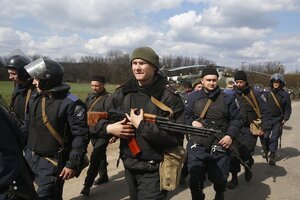Why Ukraine forces must act differently
The start of operations against protesters in eastern Ukraine will be a test of the country's new commitment to democratic rights, such as peaceful assembly. Soldiers must now show restraint against unarmed demonstrators, less so against armed ones. This will influence Russia's actions.

Ukrainian police walk with Army troops near Izyum in eastern Ukraine April 15.
AP Photo
One gauge of how much a country embraces democracy is whether its security forces honor the right of assembly and refuse to shoot protesters. In Ukraine, the previous regime failed that test. Over the winter, forces under President Viktor Yanukovych killed more than 100 pro-democracy protesters in Kiev’s public areas. After enough soldiers refused to shoot, he was forced to flee.
Now an interim regime, one with a strong commitment to democracy and fresh elections scheduled for May 25, faces a similar test. Will the same Ukrainian forces under a new commander be able to peacefully end the occupation of public buildings by Russian-speaking protesters in eastern cities?
Or will they resort to the same old shoot-and-kill?
On Tuesday, acting President Olexandr Turchinov initiated military operations to retake areas in the east where he has lost control. Many of the protesters are unarmed and simply seek autonomy for the region. But many are not. They may be backed by the Russian regime of President Vladimir Putin.
Ukrainian forces must act with restraint against peaceful protesters, but less so against those with guns in public places. If they can do this, they will have shown they have absorbed the civic value of a right to nonviolent protest.
Ukraine has had two revolutions for democracy (2004 and 2013). But it’s not clear if democratic values have yet to sink in. While the rest of the world watches what Russia might do in Ukraine, just as important is what Ukrainian forces will do with the protesters in eastern cities.
Ukraine’s string of demonstrations are the latest in a burst of protests worldwide. Between 2006 and mid-2013, 842 protests occurred in 84 countries, driven in large part by a lack of “real democracy,” according to a survey by the Initiative for Policy Dialogue and a German foundation, Friedrich-Ebert-Stiftung. They ranged from the Arab Spring to the Occupy movement. At least two protests were the largest on record: 100 million in India and 17 million in Egypt. In over half, authorities resorted to harsh repression. The most deaths were reported in Kyrgyzstan, Egypt, and Kenya; the most injuries occurred in Egypt, Thailand, and Algeria.
In democracies, police and soldiers are loyal to a country’s values, usually embodied in a constitution. Under authoritarian regimes, loyalty is mixed, often driven by fear, financial incentives, or loyalty to a clan or ethnic group.
The recent rise in protests led the UN Human Rights Council to set up a special office in 2010 dedicated to promoting the freedom of peaceful assembly and of association. In a report last year, the office noted repression of nonviolent protests in Algeria, Azerbaijan, Bahrain, Belarus, China, Cuba, Egypt, Iran, Indonesia, Russia, Syria, and Zimbabwe. Many of these regimes are afraid of protests – and the world witnessing a crackdown on protesters. In recent weeks, many of them, along with India and South Africa, have tried to restrict UN support of the basic right to peaceful protest.
Ukraine’s current struggles are a reflection of a global one. One of Kiev’s best defenses against Russian meddling is to make sure its forces act according to democratic values. That only happens soldier by soldier. To a large degree, the heart of Ukraine’s democratic revolution lies in the heart of the soldiers with guns.

